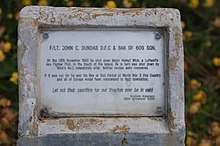Rudolf Pflanz
Rudolf Pflanz (1 July 1914 – 31 July 1942) was a German Luftwaffe fighter pilot and recipient of the Knight's Cross of the Iron Cross during World War II. Pflanz claimed 52 aerial victories, all of them over the Western Front.
Rudolf Pflanz | |
|---|---|
| Born | 1 July 1914 Ichenheim, German Empire |
| Died | 31 July 1942 (aged 28) Berck-sur-Mer, German-occupied France |
| Buried | war cemetery at Bourdon, France |
| Allegiance | |
| Service/ | |
| Years of service | ?–1942 |
| Rank | Hauptmann (Posthumously) |
| Unit | JG 2 |
| Battles/wars | World War II |
| Awards | Knight's Cross of the Iron Cross |
Career
Pflanz was born in July 1914 in Ichenheim. He joined the Luftwaffe and by 1938 was serving with JG 131, which was later redesignated Jagdgeschwader 2 (JG 2—2nd Fighter Wing). Following the outbreak of war Pflanz recorded his first victory on 30 April 1940 sharing a Potez 63/11 reconnaissance aircraft with two other pilots of 3 Staffel. His next victory was on 14 May, when he shot down a Bristol Blenheim bomber.

During the Battle of Britain, Pflanz was wingman to Major Helmut Wick in the Stab I./JG 2, and on 28 November 1940 probably shot down Royal Air Force (RAF) ace Flight Lieutenant John Dundas of No. 609 Squadron just after Dundas had shot down and killed Wick. By the end of 1940 Pflanz had eight victories.
On 23 July 1941 Pflanz claimed five Spitfires and a Hurricane shot down, and consequently claimed "ace-in-a-day" status. JG 2 claimed 29 RAF fighters that day with a further 10 credited to JG 26. Actual RAF losses amounted to 15 aircraft suggesting a high degree of over-claiming.
After recording his 20th victory he was awarded the Knight's Cross of the Iron Cross on 1 August 1941, and by the end of the year his total was 23. Oberleutnant Pflanz was appointed Staffelkapitän of 11./JG 2 in May 1942, a special high-altitude unit equipped with the Bf 109G-1 fitted with pressurised cockpits. On 5 June he claimed three Spitfires downed over the Somme. On 31 July 1942 Pflanz was killed while engaging Spitfires of No. 121 Squadron over Berck-sur-Mer, France. Prior to being shot down and killed, he had destroyed one Spitfire. Pflanz is buried in the war cemetery at Bourdon, on the Somme.
He was posthumously promoted to the rank of Hauptmann. Pflanz was credited with 52 victories, all recorded over the Western Front, which included 45 Spitfires.
Awards
- Flugzeugführerabzeichen
- Ehrenpokal der Luftwaffe (24 July 1941)[1]
- Front Flying Clasp of the Luftwaffe
- Iron Cross (1939)
- 2nd Class
- 1st Class
- Knight's Cross of the Iron Cross on 1 August 1941 as Oberleutnant and pilot 1./Jagdgeschwader 2[2][Note 1]
- German Cross in Gold on 16 July 1942 as Oberleutnant in the I./Jagdgeschwader 2[4]
Notes
- According to Scherzer as pilot in the Stab/Jagdgeschwader 2 "Richthofen".[3]
References
Citations
- Obermaier 1989, p. 178.
- Fellgiebel 2000, p. 275.
- Scherzer 2007, p. 592.
- Patzwall & Scherzer 2001, p. 350.
Bibliography
- Fellgiebel, Walther-Peer (2000) [1986]. Die Träger des Ritterkreuzes des Eisernen Kreuzes 1939–1945 — Die Inhaber der höchsten Auszeichnung des Zweiten Weltkrieges aller Wehrmachtteile [The Bearers of the Knight's Cross of the Iron Cross 1939–1945 — The Owners of the Highest Award of the Second World War of all Wehrmacht Branches] (in German). Friedberg, Germany: Podzun-Pallas. ISBN 978-3-7909-0284-6.
- Obermaier, Ernst (1989). Die Ritterkreuzträger der Luftwaffe Jagdflieger 1939 – 1945 [The Knight's Cross Bearers of the Luftwaffe Fighter Force 1939 – 1945] (in German). Mainz, Germany: Verlag Dieter Hoffmann. ISBN 978-3-87341-065-7.
- Patzwall, Klaus D.; Scherzer, Veit (2001). Das Deutsche Kreuz 1941 – 1945 Geschichte und Inhaber Band II [The German Cross 1941 – 1945 History and Recipients Volume 2] (in German). Norderstedt, Germany: Verlag Klaus D. Patzwall. ISBN 978-3-931533-45-8.
- Scherzer, Veit (2007). Die Ritterkreuzträger 1939–1945 Die Inhaber des Ritterkreuzes des Eisernen Kreuzes 1939 von Heer, Luftwaffe, Kriegsmarine, Waffen-SS, Volkssturm sowie mit Deutschland verbündeter Streitkräfte nach den Unterlagen des Bundesarchives [The Knight's Cross Bearers 1939–1945 The Holders of the Knight's Cross of the Iron Cross 1939 by Army, Air Force, Navy, Waffen-SS, Volkssturm and Allied Forces with Germany According to the Documents of the Federal Archives] (in German). Jena, Germany: Scherzers Militaer-Verlag. ISBN 978-3-938845-17-2.